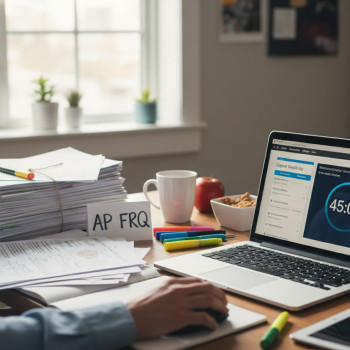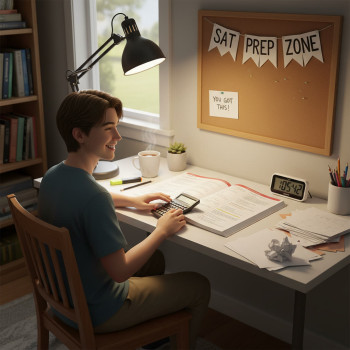Introduction: Why What You Eat Matters for the Digital SAT
Think of your brain as a high-performance engine. When it runs on the right fuel, it’s responsive, efficient, and sharp. When it’s underfueled, jittery, or weighed down, its performance drops — and on a long, concentrated exam like the Digital SAT, that difference can be the gap between a good score and your best score.
This article walks you through the science-backed ways diet impacts attention, memory, and stamina, and gives you practical, student-friendly meal plans, snack options, and day-of-test strategies. Along the way I’ll share realistic examples, a comparison table of food choices, and tips to sync nutrition with study routines. For students who want extra structure, Sparkl’s personalized tutoring — with 1-on-1 guidance, tailored study plans, expert tutors, and AI-driven insights — can help you combine smart nutrition with focused study habits.
The basics: How food affects focus and cognition
Three key factors link diet to how well you concentrate on exam day: stable energy delivery, mood regulation, and hydration. When these are in balance, you can sustain attention for longer, switch between tasks efficiently, and retrieve information more reliably.
1. Stable blood sugar = steady focus
The brain runs almost entirely on glucose. But steady supply matters more than sheer quantity. Rapid spikes and crashes in blood sugar — often caused by sugary snacks or refined carbs — lead to short bursts of energy followed by fogginess, irritability, and reduced working memory. Lean toward foods that release glucose gradually: whole grains, legumes, certain fruits, and proteins.
2. Mood and neurotransmitters
Neurotransmitters such as dopamine and serotonin influence motivation and calmness. Building blocks for these chemicals come from nutrients in your diet: tryptophan-rich foods (turkey, yogurt), omega-3 fats (fatty fish, walnuts), and B-vitamins (whole grains, leafy greens) help your brain maintain a stable mood and resist test anxiety.
3. Hydration and alertness
Even mild dehydration (a loss of 1–2% of body weight) can reduce concentration, slow reaction time, and make you feel tired. Water is the simplest way to protect mental clarity. Caffeinated beverages help short-term alertness but can backfire if you rely on them too heavily or if they cause jitteriness.
Common pitfalls students fall into
- Skipping breakfast because you’re nervous or pressed for time — this removes steady glucose supply just when you need it.
- Loading on sugary energy drinks or candy for a quick boost — fast crash later.
- Eating unfamiliar or overly rich meals before test day — digestive discomfort is a focus killer.
- Overdoing caffeine — can increase anxiety and cause stomach upset or a mid-exam energy dip.
Pre-test nutrition timeline: What to eat the week before, the day before, and the morning of the test
Optimizing cognition is both short-term and cumulative. Your brain benefits from consistent good nutrition in the days leading up to the exam, and from a predictable routine on test morning.
The week before: build a steady base
Focus on well-rounded meals rich in complex carbs, lean proteins, healthy fats, and vegetables.
- Breakfasts: oatmeal with nuts and berries; yogurt with granola and fruit; whole-grain toast with nut butter and banana.
- Lunch and dinner: grains or sweet potato + lean protein (chicken, beans, fish) + vegetables + a small portion of healthy fats (olive oil, avocado).
- Snacks: raw nuts, fruit, hummus with carrot sticks, whole-grain crackers with cheese.
- Sweets and late-night meals: keep them moderate. Cutting way back on late-night sugar and heavy fried food gives you more consistent sleep and alertness.
The day before: comfort and predictability
Aim for familiar, easily digestible meals that you know agree with you. Avoid heavy fried foods, very spicy dishes, and large portions that could interfere with sleep.
- Good dinner example: baked salmon (or a plant-protein alternative), quinoa or brown rice, mixed veggies, and a side salad.
- Evening: a light snack before bed is fine — Greek yogurt with honey or a small banana — if you typically sleep well after eating.
Test morning: a balanced breakfast that lasts
This is the most important single meal for test-day focus. Eat 1.5–3 hours before the test starts if possible.
- Include: complex carbs + protein + healthy fat + a bit of fruit.
- Examples: bowl of steel-cut oats with milk, walnuts, and blueberries; whole-grain toast with scrambled eggs and avocado; a smoothie with banana, spinach, Greek yogurt, and a spoonful of nut butter (not too sugary).
- Hydrate: 12–16 oz (350–475 mL) of water with breakfast, and sip a small bottle of water on the way to the testing center.
Practical snack strategies for the Digital SAT
The Digital SAT includes breaks when you can refuel. Use those moments to restore steady energy without overdoing sugars.
- Portable, slow-release snacks: a small handful of mixed nuts, a banana, a rice cake with almond butter, or a cheese stick.
- Caffeine strategy: if you normally use caffeine, a modest amount before the test can help — but don’t try caffeine for the first time on test day.
- Avoid: candies and sugary sodas that cause rapid energy swings, overly salty chips that can make you thirstier, and heavy pastries that induce sluggishness.
Quick comparison table: best and worst pre-test food choices
| Category | Smart Choices | What to Avoid | Why |
|---|---|---|---|
| Breakfast | Oatmeal, eggs, whole-grain toast, fruit | Donuts, sweet pastries, sugary cereal | Complex carbs + protein = steady glucose; sugary options spike then crash. |
| Snacks | Nuts, banana, yogurt, cheese stick | Energy drinks, candy bars | Protein/fat slow digestion; sugary snacks lead to short-lived energy. |
| Dinner (night before) | Grilled fish, chicken, beans, veggies, quinoa | Greasy fast food, very spicy meals, heavy fried items | Lighter, balanced meals support sleep; heavy meals can cause discomfort and restless sleep. |
| Hydration | Water, herbal tea | Excessive soda, too much coffee | Hydration supports cognition; too much sugar/caffeine increases jitteriness. |
Sample meal plan for test day (timed and practical)
Below is a suggested schedule for a morning exam with a mid-test break. Adjust times to match your test window and your personal routine.
- 2–3 hours before test: Breakfast — bowl of steel-cut oats with milk, sliced banana, walnuts, and a drizzle of honey; glass of water.
- 30–60 minutes before test: small sip of water, 1 small piece of fruit if you tend to get hungry (apple or a few grapes).
- Mid-test break: small snack — 10–12 almonds, half a banana, and water; short walk or deep-breathing for 3–5 minutes.
- After test: replenishing meal that combines protein and carbs — turkey sandwich on whole-grain bread with veggies, or a rice bowl with beans and roasted veggies.
Putting it into practice: study-phase nutrition and energy management
Nutrition isn’t only about test day. The weeks and months you spend preparing for the Digital SAT are when you build important cognitive habits.
- Study snacks: Keep brain-friendly snacks at your desk — raw almonds, carrot sticks with hummus, sliced apple with peanut butter.
- Meal timing: Long study blocks pair well with a protein-rich lunch to avoid afternoon slumps. Try incorporating short breaks and a light snack halfway through long sessions.
- Sleep and food: Regular meal timing and limiting late-night heavy eating help maintain circadian rhythm and improve memory consolidation during sleep.
Real-world context: anecdotes that illustrate the difference
Here are two quick, composite student profiles that show how small changes can make a noticeable difference.
- Maya: Used to skip breakfast and grab a sugary pastry before tests. She felt alert for the first 30 minutes, then experienced trouble sustaining attention. After switching to Greek yogurt, berries, and a small handful of nuts, she reported feeling calmer and able to track complex reading passages for longer.
- Jordan: Relied on large energy drinks. They reduced his fatigue short-term but increased jitteriness and bathroom breaks. By switching to a smaller coffee and pairing it with an apple and almonds, he preserved alertness without the crash.
When to consult a professional
If you have a medical condition (diabetes, severe food intolerances, or digestive disorders) or you’re on medication that affects appetite or hydration, talk to a healthcare provider about test-day nutrition. Also consult a registered dietitian if you want a tailored plan to optimize cognition and overall health.
How Sparkl’s personalized tutoring can help you integrate diet and study
Nutrition and study techniques are most powerful when coordinated. Sparkl’s 1-on-1 tutors can help you develop a routine that aligns meal timing, practice tests, and sleep patterns. Tutors provide tailored study plans and AI-driven insights that identify when your focus tends to wobble during practice sessions — so you can adjust snack timing, hydration, and short break strategies to match your cognitive rhythms. That practical integration can turn small, consistent changes in diet into measurable improvements in practice test scores.
Practical checklist: the week and morning before your Digital SAT
- One week before: choose familiar, balanced meals and practice your morning routine on a practice test day.
- Two days before: stabilize sleep schedule and avoid heavy late-night eating.
- Night before: eat a moderate, familiar dinner and avoid alcohol or extreme caffeine.
- Test morning: balanced breakfast with complex carbs, protein, and healthy fats; hydrate; pack a small, slow-release snack for the break.
- During the test: sip water, take controlled short breaks, and refuel lightly at the scheduled break.
FAQ: Short answers to common student questions
Can I rely on caffeine for the whole test?
Moderate caffeine can improve alertness, but it’s best used predictably. If you regularly consume caffeine, a small, familiar dose before the test can help. Don’t try large amounts or a new caffeinated product on test day.
What if I’m nervous and can’t eat?
Even small amounts help. Try a smoothie (easy to swallow) or a banana with a spoonful of peanut butter. Practice this during a mock test morning to see what your stomach tolerates.
Are supplements like omega-3s or B-vitamins helpful?
Some nutrients support long-term cognitive health, but they’re not quick fixes. If you consider supplements, consult a healthcare professional. Focus first on whole-food strategies: balanced meals, hydration, and sleep.
Closing: small choices, big difference
Preparing for the Digital SAT is about more than strategy questions and timed practice — it’s about building a dependable cognitive environment. Diet is one of the most controllable parts of that environment. By choosing steady, nutrient-dense foods, staying hydrated, and practicing your test-day routine, you give your brain the conditions it needs to perform at its best.
If you’d like help making a plan that combines study strategy with practical nutrition and timing, Sparkl’s tutors can offer 1-on-1 guidance, tailored study plans, and AI-driven insights to figure out what works best for your body and schedule. Small, consistent changes add up — and when the test day comes, you’ll be ready to focus, think clearly, and do your best.
Good luck — fuel well, practice smart, and trust your preparation. You’ve got this.

















No Comments
Leave a comment Cancel